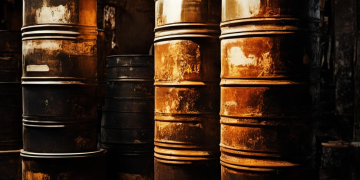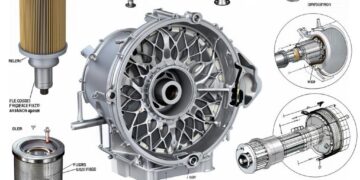Содержание
трансмиссионные масла
Изучив содержание предыдущих глав данного раздела вы получили краткий обзор того, что же представляет из себя любое трансмиссионное масло и на основании чего его выбирать. Итак, необходимые знания получены, выбор в пользу того или иного масла сделан — идем покупать его в магазин. Однако, здесь нам потребуется ещё одно знание, а, точнее, умение читать и правильно трактовать данные на упаковочной таре.
маркировка трансмиссионных масел
Любое трансмиссионное масло на этикетке, как правило содержит следующую информацию:
- 1. Название фирмы производителя (и (или) фирменное название) и назначение масла;
- 2. Класс масла, определяющий его кинематическую вязкость по ГОСТ 17479.2-85;
- 3. Группу масла, определяющую его эксплуатационные свойства;
- 4. Вид базовой основы (минеральное, синтетическое, полусинтетическое);
- 5. Номер партии;
- 6. Дата выпуска и срок годности.
С номером партии наверняка всё понятно
Уделять внимание данному значению, надеюсь, вряд ли есть острая необходимость. Данный показатель может вам пригодится лишь в случае предъявления рекламаций по качеству продукта
С датой выпуска и сроком годности то же не должно возникнуть вопросов. А вот остальные параметры …
Рассмотрим маркировку масла на конкретном примере, но сразу оговоримся во избежание предвзятости: приведенная в примере марка масла не является рекомендацией автора по её желательному применению, а служит лишь в качестве примера и в целях, обозначенных в названии данной главы.
Обозначение трансмиссионных масел России и стран СНГ включает буквенный индекс ТМ, который в буквальном смысле обозначает — масло трансмиссионное, следующая за индексом цифра — группа масла по эксплуатационным свойствам и последняя цифра — класс вязкости. В нашем случае имеем следующее: ТМ-5 — масло трансмиссионное, 5-й группы по эксплуатационным свойствам. Постойте, скажите вы, но в данной маркировке отсутствует вторая цифра через тире, обозначающая класс вязкости?! Кстати, популярное ранее трансмиссионное масло ТАД-17И в соответствии с ГОСТ 17479.2-85 обозначалось именно так: ТМ-5-18.
Всё правильно, именно такое обозначение присутствовало на маслах ранее. Сегодня производители трансмиссионных масел для удобства потребителя всё чаще и чаще указывают на своих продуктах кинематическую вязкость согласно классификации SAE, так как данная классификация наиболее четко и понятно для потребителя привязывает класс вязкости к эксплуатации конкретного масла.
Итак, читаем:
- 1. Название фирмы производителя (и (или) фирменное название) и назначение масла: «Лукойл» — трансмиссионное;
- 2. Класс масла по кинематической вязкости согласно классификации SAE: 85W-90 (по ГОСТ 17479.2-85, соответственно — 18 класс);
- 3. Группа масла, в соответствии с классификацией по эксплуатационным свойствам по ГОСТ: 5(по API, соответственно — GL-5);
- 4. Вид базовой основы: минеральная;
Расшифруем пункт 2:
Маркировка кинематической вязкости по SAE: 85W-90 читается следующим образом:
- 85W — кинематическая вязкость при отрицательных температурах (иными словами: зимняя вязкость)
- 90 — кинематическая вязкость при положительных температурах (летняя вязкость)
Подробнее о том, как определяется вязкость трансмиссионных масел и как масла классифицируются по вязкости и эксплуатационным свойствам читаем в соответствующих главах данного раздела.
Приблизительное соответствие классов кинематической вязкости и групп трансмиссионных масел по ГОСТ 17479.2-85 классификациям SAE и АРI приведено в таблице ниже:
| Класс вязкости по ГОСТ 17479.2-85 | Класс вязкости по SAE | Группа по ГОСТ 17479.2-85 | Группа по АРI |
| 9 | 75W | ТМ-1 | GL-1 |
| 12 | 80W/85W | ТМ-2 | GL-2 |
| 18 | 90 | ТМ-3 | GL-3 |
| 34 | 140 | ТМ-4 | GL-4 |
| — | — | ТМ-5 | GL-5 |
Отечественные стандарты
В нашей стране трансмиссионные масла, исходя из вязкостных и эксплуатационных характеристик, классифицируются по принятому стандарту — ГОСТ 17479.2–85. По вязкости их делят на 4 класса: 9, 12, 18, 34. Принадлежность к определенному классу определяется по кинематической вязкости при 100 °С и минимальной температуре, при которой показатели динамической вязкости не превышают 150 Па•c.
Эксплуатационные свойства и сфера применения масел легли в основу их деления на 5 групп. Состав продуктов, относящихся к первой группе, не содержит присадок. Смазочные материалы остальных четырех групп содержат в своем составе противоизносные присадки, причем, чем больше номер группы, тем эффективнее присадки. В пятую группу входят также универсальные смазочные материалы для трансмиссий.
Отечественная система обозначения масел для трансмиссий включает маркировку по классу вязкости и уровню эксплуатационных характеристик (ТМ-2-9 или ТМ-3-18). В настоящее время, в условиях проникновения на авторынок большого количества зарубежных продуктов, отечественную классификацию вытеснили международные стандарты.
Современная классификация
Как и для моторных масел, для трансмиссионных принятой классификацией являются стандарты Американского Института Нефти (API).
Масла группы GL-1 – это смазки для малонагруженных трансмиссий на минеральной базе с минимальным пакетом присадок. Ни в одном современном автомобиле подобные масла не применяются. Неактуальны для автомобилистов и более богатые противоизносными присадками масла GL-2 – они используются в низкооборотных червячных редукторах.
Для средних нагрузок в низкооборотных трансмиссиях предназначены масла группы GL-3. Эта группа трансмиссионных масел применяется в механических коробках передач и спирально-конических редукторах ведущих мостов за счет увеличенного содержания противоизносных присадок, но актуальны для грузового транспорта.
Automotive Gear Lubricant Viscosity Classification
inactive
Buy Now
| Organization: | SAE |
| Publication Date: | 1 June 2005 |
| Status: | inactive |
| Page Count: | 4 |
scope:
This SAE Standard defines the limits for a classification of
automotive gear lubricants in
rheological terms only. Other lubricant characteristics are not
considered.
Rationale
Two new viscosity grades were added to the viscosity classification as
part of the January 2005
update. The new grades are SAE 110 (100 °C viscosity between 18.5
and 24.0 cSt) and SAE 190
(100 °C viscosity between 32.5 and 41.0 cST). The need for the two
additional grades centered
on the wide variation in kinematic viscosity possible within the prior
version of J306 for SAE 90
and the SAE 140 grades. The effect of such a wide range of kinematic
viscosities could result in an
axle being serviced with a lubricant that had a viscosity
significantly lower or higher than the
axle lubricant that the axle had been validated with, even though the
same viscosity grade had been
employed. OEMs may have been forced to specify a higher viscosity
grade than what they may actually
desire, because the wide range of kinematic viscosities of the next
lower grade could result in
customers using a lubricant having too low of a kinematic viscosity.
For example: An OEM would like
to recommend a lubricant having a 100 °C viscosity of 19.5 cSt,
which according to the prior
version of J306 requirements would be SAE 90. However, if the OEM had
recommended a SAE 90 the
actual viscosity could be as low as 13.5 cSt, which may be lower than
the OEM is comfortable with.
Thus, the OEM recommended a SAE 140, which ensures that the 100 °C
viscosity is never lower
than the desired 19.5. Unfortunately, that also means that the
viscosity could be as high as 41.0
cSt. Under the new limits the OEM could recommend a SAE 110 which
would meet the 19.5 cSt
requirement and the axle would not be serviced with anything higher in
viscosity than 31 cSt.
An additional change to J306 was the inclusion for the use of ASTM D
3244 for resolving any
disputes between laboratories as to whether a product conforms with
any specification in Table 1.
The test designation for the KRL Shear Stability Test was also updated
to the current designation.
Document History
SAE J306
February 1, 2019
(R) Automotive Gear Lubricant Viscosity Classification
This SAE Standard defines the limits for a classification of automotive gear lubricants in rheological terms only. Other lubricant characteristics are not considered.
SAE J306
August 1, 2017
Automotive Gear Lubricant Viscosity Classification
This SAE Standard defines the limits for a classification of automotive gear lubricants in rheological terms only. Other lubricant characteristics are not considered.
SAE J306
June 1, 2005
Automotive Gear Lubricant Viscosity Classification
This SAE Standard defines the limits for a classification of automotive gear lubricants in rheological terms only. Other lubricant characteristics are not considered.
Rationale
Two new viscosity…
SAE J306
July 1, 1998
(R) Automotive Gear Lubricant Viscosity Classification
This SAE Standard defines the limits for a classification of automotive gear lubricants in rheological terms only. Other lubricant characteristics are not considered.
J306
October 1, 1991
Axle and Manual Transmission Lubricant Viscosity Classification
A description is not available for this item.
SAE J306
March 1, 1985
Axle and Manual Transmission Lubricant Viscosity Classification
APPLICATION:
This SAE Standard is intended for equipment manufacturers in defining and recommending axle and manual transmission lubricants, for oil marketers in labeling such lubricants with…
SAE J306
May 1, 1981
Axle and Manual Transmission Lubricant Viscosity Classification
A description is not available for this item.
SAE J306
February 1, 1924
Axle and Manual Transmission Lubricant Viscosity Classification
A description is not available for this item.
View Less
View Less
View All
References
Gear oil is a lubricant made specifically for transmissions, transfer cases, and differentials in automobiles, trucks, and other machinery. It is of a high viscosity and usually contains organosulfur compounds. Some modern automatic transaxles (integrated transmission and differential) do not use a heavy oil at all but lubricate with the lower viscosity hydraulic fluid, which is available at pressure within the automatic transmission. Gear oils account for about 20% of the lubricant market.Most lubricants for manual gearboxes and differentials contain extreme pressure (EP) additives and antiwear additives to cope with the sliding action of hypoid bevel gears. Typical additives include dithiocarbamate derivatives and sulfur-treated organic compounds («sulfurized hydrocarbons»).
EP additives which contain phosphorus/sulfur compounds are corrosive to yellow metals such as the copper and/or brass used in bushings and synchronizers; the GL-1 class of gear oils does not contain any EP additives and thus finds use in applications which contain parts made of yellow metals.
GL-5 is not necessarily backward-compatible in synchro-mesh transmissions which are designed for a GL-4 oil: GL-5 has a lower coefficient of friction due to the higher concentration of EP additives over GL-4, and thus synchros can not engage as effectively.
Motor oil, engine oil, or engine lubricant is any of various substances comprising base oils enhanced with particularly antiwear additive plus detergents, dispersants and, for multi-grade oils viscosity index improvers. Motor oil is used for lubrication of internal combustion engines. The main function of motor oil is to reduce friction and wear on moving parts and to clean the engine from sludge (one of the functions of dispersants) and varnish (detergents). It also neutralizes acids that originate from fuel and from oxidation of the lubricant (detergents), improves sealing of piston rings, and cools the engine by carrying heat away from moving parts.In addition to the basic constituents noted in the preceding paragraph, almost all lubricating oils contain corrosion and oxidation inhibitors. Motor oil may be composed of only a lubricant base stock in the case of non-detergent oil, or a lubricant base stock plus additives to improve the oil’s detergency, extreme pressure performance, and ability to inhibit corrosion of engine parts.
Motor oils today are blended using base oils composed of petroleum-based hydrocarbons, polyalphaolefins (PAO) or their mixtures in various proportions, sometimes with up to 20% by weight of esters for better dissolution of additives.
SAE J300 is a standard that defines the viscometric properties of mono- and multigrade engine oils, maintained by SAE International. Key parameters for engine oil viscometrics are the oil’s kinematic viscosity, its high temperature-high shear viscosity measured by the tapered bearing simulator, and low temperature properties measured by the cold-cranking simulator and mini-rotary viscometer. This standard is commonly used throughout the world, and standards organizations that do so include API and ILSAC, and ACEA.
| Organizations | |
|---|---|
| Standards |
|
| Awards | |
| People | |
| Competitions | |
| Related |
Список источников
- topmekhanik.ru
- NashiKolesa.ru
- standards.globalspec.com
- howlingpixel.com
- www.reduktorvaz.narod.ru





















































